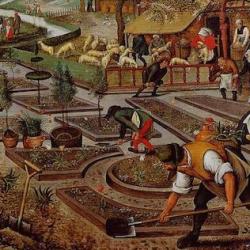In a lively meditation on money based on Daniel Graeber’s Debt: The First 5,000 Years , John Medaille challenges the standard account of the rise of money. Rather that moving from barter to money to credit, Medaille suggests that the historical evidence suggests the opposite is the case.
Village life, he says, was mainly a gift economy whose currency was honor in the community: “The fisherman, when he wants a pair of shoes, does not, as in the economists’ myth, search out a cobbler who wants some fish. Rather, he freely gives away his surplus fish, an act which gains him honor in the village; he is a man who can contribute to the village, and therefore worthy of honor. Perhaps some woman will notice that he is wearing tatty moccasins, which is not appropriate for a man of honor. She will undertake to make him some moccasins and thereby gain honor for herself. In village life, ‘honor’ is the coin of the realm, and the economic system aims at circulating goods in such a way as to bind the members of the village together in a long chain of mutual obligations.”
Even when the Mesopotamian civilizations expanded beyond the village and town and created large empires, they did so on the basis of credit rather than currency:
“Money existed as a unit of account for debts for nearly two millennia before it existed as coins and currency. As early as 3500 BC, Babylon developed as a sophisticated society with great cities, and all without the use of money, or at least without the use of currency. Currency would not begin until about 700 B.C. in Greece. In the great temples and palaces of the Babylonians (which served as the banks) we find extensive commercial records preserved in cuneiform tablets. This unit of account was the gur , the measure of barley that constituted the monthly ration, or it was the Shekel, a weight of silver whose value was arbitrarily set to the gur . Domestic debts were computed in gur , while foreign trade was conducted in silver that the temples advanced to the merchants. Debts were paid in real goods, which might be silver or barley or any other worthwhile product.”
Well into the early modern period, trade was carried out in terms of credits and debits rather than with currency and coins, credits and debits that were tracked in England with “tally sticks”: “A tally stick was a bit of hazel wood upon which a debt was recorded in the form of notches; the stick was then split in half. The creditor’s half was called the ‘stock,’ which made him the stockholder, and the debtor’s half was called the stub. The stock would circulate as money, and as long as the stub remained it was impossible to change the debt.”
For half a millennium, Englishmen used tally sticks, and they were forced out of circulation only with the creation of the bank of England in 1694 and more specifically with the passage of the bank-firnedly liberal agenda in the early 19th century. When the Liberal party came to power in 1832, “One of their first acts was to fulfill the agenda of the Bank of England. All of the tally sticks were gathered together and burned in a stove in the House of Lords. However, the fire got out of hand and burned down the Houses of Parliament. When we view Turner’s magnificent paintings of this event, we should keep in mind what it was all about.”
Currency of a sort existed alongside the tally sticks in England, btu the currency was privately issued by producers: “a baker would issue his own ‘money’ which could be redeemed for his bread, while the butcher or the cobbler would do the same for their meat and shoes. These tokens would circulate as money on market day, and at the end of the day the merchants would settle accounts between them. Note that the baker would not issue more tokens than the bread he could bake nor the cobbler for the shoes he could make; the supply of this market money was always more or less equal to the goods the money could buy.”
Money and credit do not work that way today, and Medaille offers this as the “great secret of our money system”: “before you signed the mortgage to buy your home, or the note to buy your car, or the credit slip to buy a hamburger at McDonald’s, the money to buy the home, the car, or the burger did not exist; it comes into existence in the very act of borrowing it. ” Our financial system is not a means for tracking debts; our money simply is debt.
Medaille suggests in his final paragraphs that the “marvellous tool” of money is a fire that can “either warm or destroy us,” and he urges Benedict XVI’s point that a “principle of gratuitousness” that binds society must exist in with and under financial transactions. He also suggests that the older idea that “obligations are more important than debts” is correct and thinks it possible that “amnesties are the key to economic and social order.” That is, social order rests on an economic application of “forgive us our debts.”










